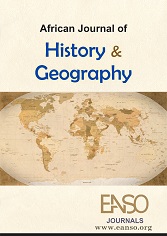Effects of Land Use Land Cover Change on Gully Development in Lugari Sub Catchment, Kakamega County in Kenya
الملخص
Worldwide Gully erosion has been considered a severe agricultural and environmental problem. In Kenya, gully erosion is treated as a serious and common socio-economic and environmental problem of different catchments. Thus, the objective of this research was to assess the diversity and effect of gully erosion in Lugari sub-catchments in Kakamega County, Kenya. The objective of the study was achieved by analysis of the data from the images and data obtained from the field observation, field measurement, GPS, interviews and household survey. The result of the study indicates that gully erosion was initiated in the mountainous area following the 1990s and 2000s land cover changes and human cause factors. In addition, the steepness of the slopes and the soil characteristics have triggered gully erosion in the study area. Gully erosion affects the physical, economic and social effects on an area. According to the group discussion and interview, the social-economic impacts of the gully were the loss of life of a 65-year-old man death and injuries to livestock and reduced yield. The result from field measurements and field observation indicated that loss of soil (1,519,487) and loss of vegetation are the major physical impacts of gully erosion. In Lugari sub-catchments there are promising rehabilitation conditions and their conditions are, availabilities for the labour force, transport serves presence of civic societies, NEMA and the green economy policy of the county. Thus, the county and National government and local communities need to set, a work plan and use the existing opportunities
التنزيلات
المراجع
A.K. Kabanza, S. Dondeyne, D.N. Kimaro, E. Kafiriti, J. Poesen & J.A. Deckers,(2013) Effectiveness of soil conservation measures in two contrasting landscape units of South Eastern Tanzania
Frankl A. (2012) Gully development and its spatio-temporal variability since the late 19th century in the northern Ethiopian highlands. Afrika Focus 25(2)
Hurni H (1988) Degradation and conservation of the resources in the Ethiopian highlands. Mt Res Dev: 123–130
Johansson, L.; Lundstrom, K.; Jonsall, A., 2002. Effects of RN genotype and silage feed on fat content and fatty acid composition of fresh and cooked pork loin. Meat Science, 60 (1): 17-24
Kenyan Population Census Report 2019.
Konana C, Gachene C, Mburu D, Mureithi S, Gicheru P, Khalif Z (2017) Drivers of gully erosion: case study. International Journal of Social Science and Technology, Narok
Mohamed MA, Anders J, Schneider C (2020) Monitoring of changes in Land Use/Land cover in Syria from 2010 to 2018 using multitemporal Landsat imagery and GIS. Land. https://doi.org/10.3390/land9070226
Nema. (2011), National guidelines for strategic environmental assessment in Kenya. Revised. February 2011. 4. Nema. The sea scoping review sheet; sea report...93 pages
Pathak P, Wani SP, Sudi R (2005) Gully control in SAT watersheds. Global theme on agroecosystems report no 15
Poesen J, Nachtergaele J., Verstraeten G, Valentin C (2003) Gully erosion and environmental change: importance and research needs. Catena 50(2–4):91–133
Stout BA (1965) Soil erosion by water, some measures for its control on cultivated lands. FAO Agric. Dev. Paper no. 81. FAO, Rome
Valentin C, Poesen J, Li Y (2005) Gully erosion: impacts, factors and control. Catena 63(2–3):132–153
Waswa F., Eggers H., Kutsch T. and Gachene, C.K.K., 2000: Community capacity Building as an opportunity for sustainable land management: lessons from Ndome and Ghazi in Taita Taveta District, Kenya. J. Agricult. Trop. Subtrop. 101: 181–189
الحقوق الفكرية (c) 2024 Khisa Kauf Daniel, Shadrack Kiana Murimi, PhD, Mary Makokha, PhD

هذا العمل مرخص حسب الرخصة Creative Commons Attribution 4.0 International License.




























